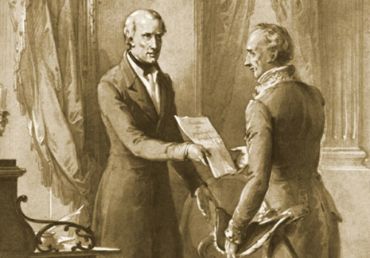1816–1818
1816 – 1818 | 1818 – 1878 | 1878 – 1922 | 1922 – 1938 | 1938 – 1945 | 1945 – 1998 | from 1999 |
Foundation of the bank and provisional governance
Historical background

The ruling Habsburg dynasty struggled with the issue of paper money for nearly 50 years before founding a central bank in Austria: Banknotes – known as “Bancozettel” at the time – were first issued in 1762 by an institution that enjoyed the confidence of the business community precisely because it was not government-controlled: the Municipal Bank of Vienna (Wiener Stadtbank), originally founded in 1705.
During the Napoleonic wars, government stepped in, however, and took direct control of banknote issuance, causing the supply of banknotes in circulation to increase sharply a number of times. Thus, the total value of “Bancozettel” in circulation swelled from 44 million florins (“Gulden”) in 1796 to 942 million florins by 1810. In business transactions, banknotes increasingly replaced silver and copper coins, confirming Gresham’s Law, according to which “bad money” drives out “good money.” When the government decreed that paper money had to be accepted as legal tender in private commercial transactions, the market responded by trading banknotes at rapidly rising discounts to their face value. To give an example: While “Bancozettel” with a face value of 100 florins were redeemed for only 92 florins in silver coins in 1799, inflation had reduced the value of “Bancozettel” to a mere 15% of the face value by December 1810. Soldiers on the battlefield even rebelled against the obligation to accept “Bancozettel” as legal tender. When the Habsburgs eventually devalued the banknotes at a ratio of 5 to 1, the business community considered this move to be tantamount to sovereign default. Despite strong assurances of the government to refrain from excessive issuance of banknotes from then on, the currency, now labeled “Viennese currency,” continued to depreciate rapidly.
Independence guaranteed
,%20erster%20Gouverneur%20der%20privilegirten%20oesterreichischen%20Nationalbank%201816-1817.jpg)
When the political balance in Europe was restored at the end of the Napoleonic wars, the Austro-Hungarian Empire faced enormous challenges. With their territory spanning many divergent ethnic groups, the Habsburgs could no longer rely only on their traditional pillars of societal support – the Church, the nobility, the army and the civil service – to hold together their Empire: The Empire also needed a sound economic basis for integration to work. Therefore, the government had to regain the confidence of the business community. The basic economic law of supply and demand was not to be overridden – it was binding even for the Emperor. Against this backdrop, the Emperor issued two exclusive rights called “patents” on June 1, 1816, namely the “financial patent” and the “bank patent,” thus creating a central bank: The “privilegirte oesterreichische National-Bank” started operation on the same day. The preparatory work had been masterminded by Count Johann Philipp von Stadion, the Austrian finance minister at the time.
It took the creation of a central bank, which would in due course have the exclusive right to issue banknotes, for the Austrian monetary system to stabilize and public confidence in the monetary system to return. The banknotes appreciated in value once again, thanks to circumspect monetary policymaking. In other words, putting the job of supplying the economy with cash into the hands of an institution that was committed to maintaining price stability had been the right move. Yet to be able to maintain price stability, the central bank had to be independent of government as well – it had to able to prevent the finance minister from firing up the printing press. Independence was strengthened by capitalizing the bank through the sale of shares to investors.
Initially, the activities of the central bank were limited to the redemption of the old paper money and the issuance of shares under a provisional governance structure. For the bank to become operational with full-fledged management, public subscription of a thousand shares was required.
